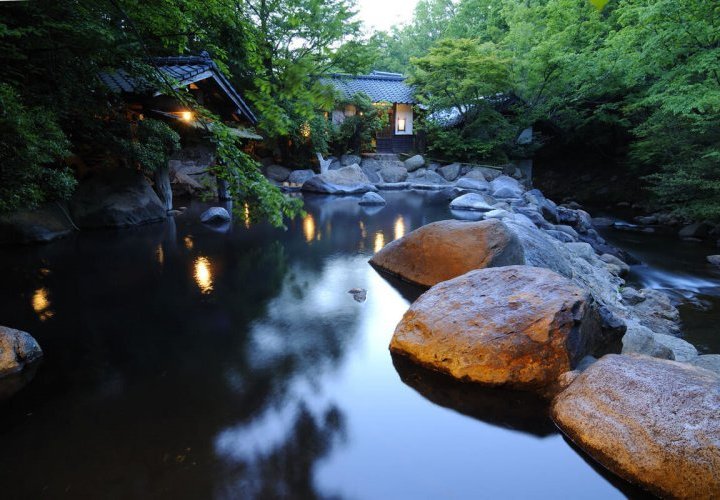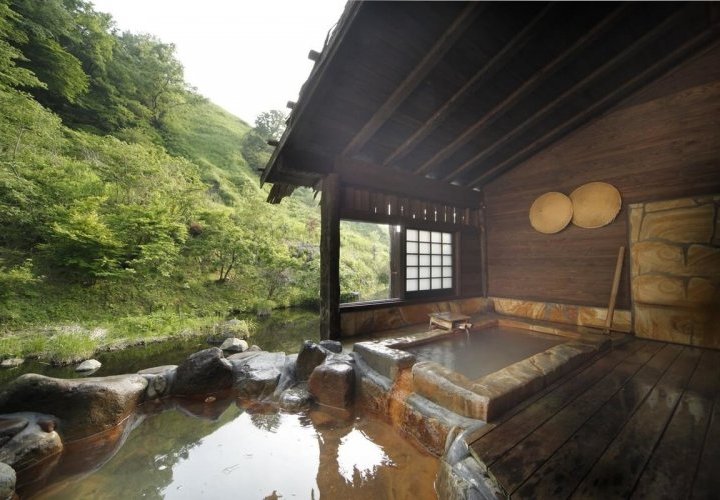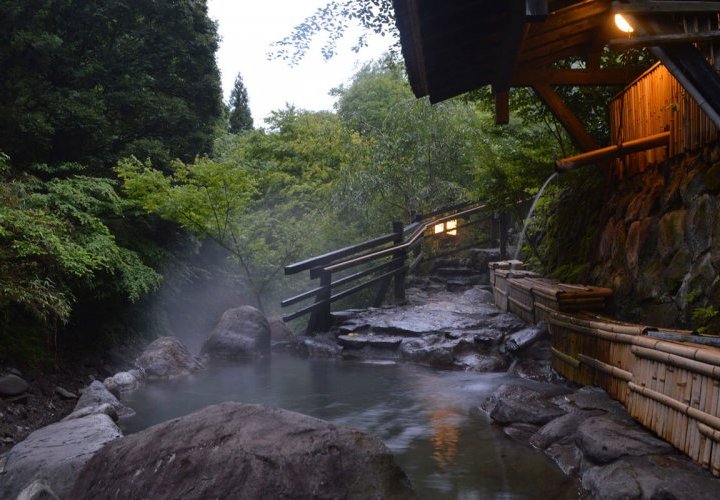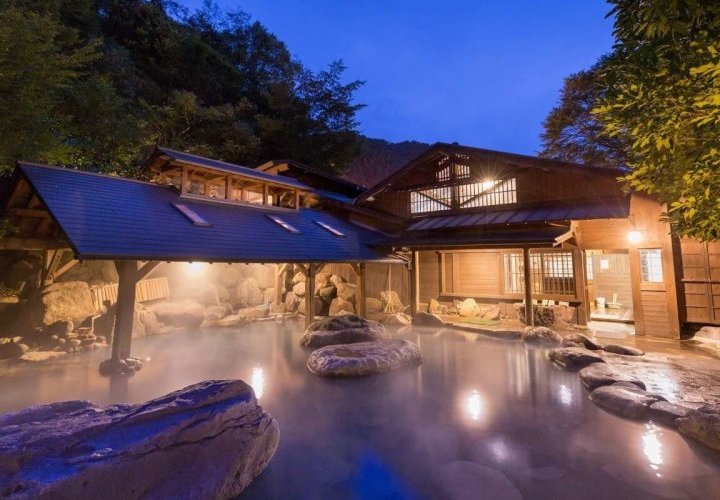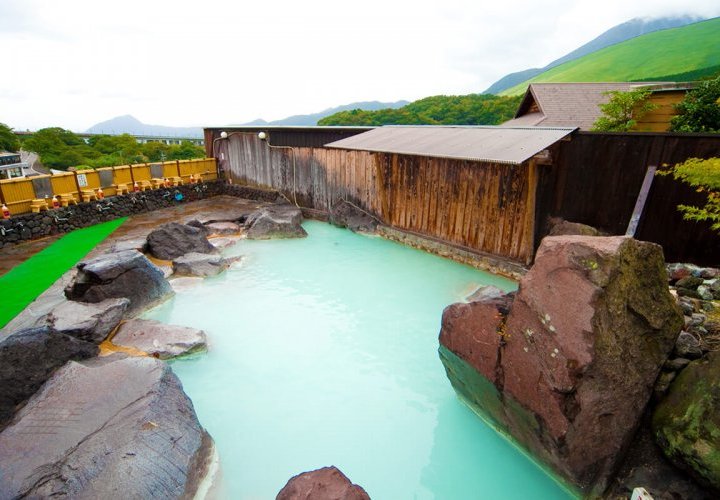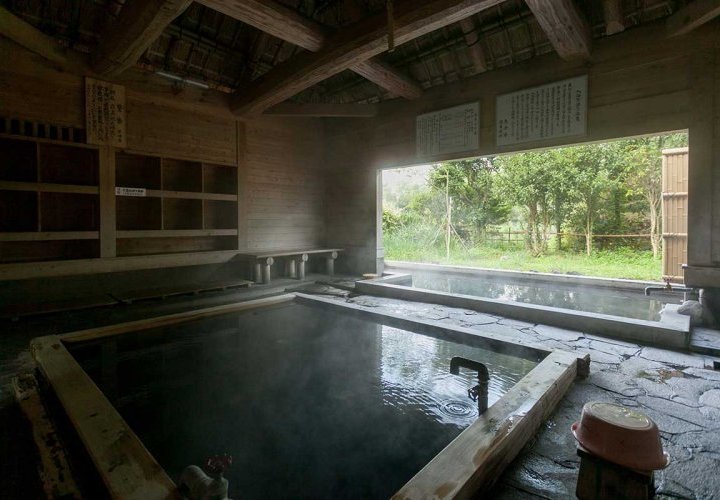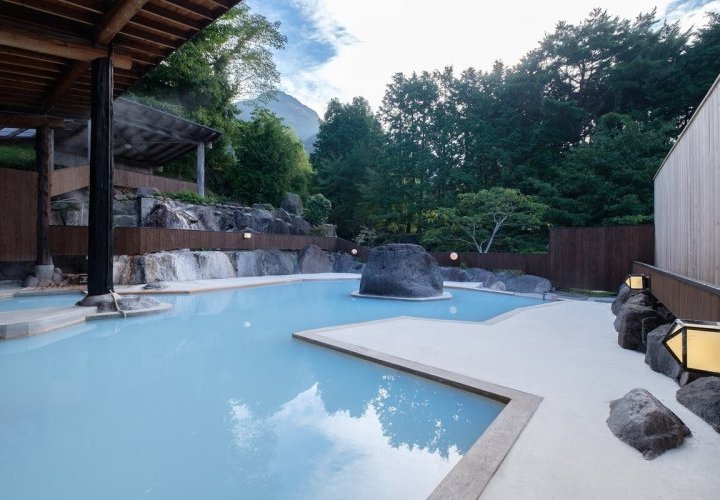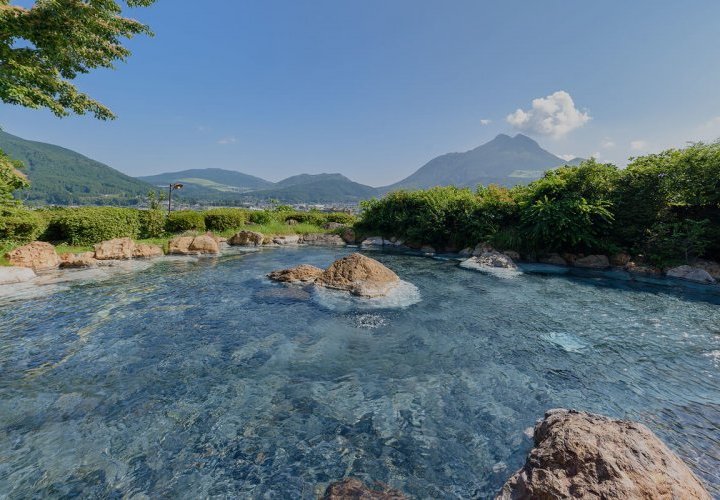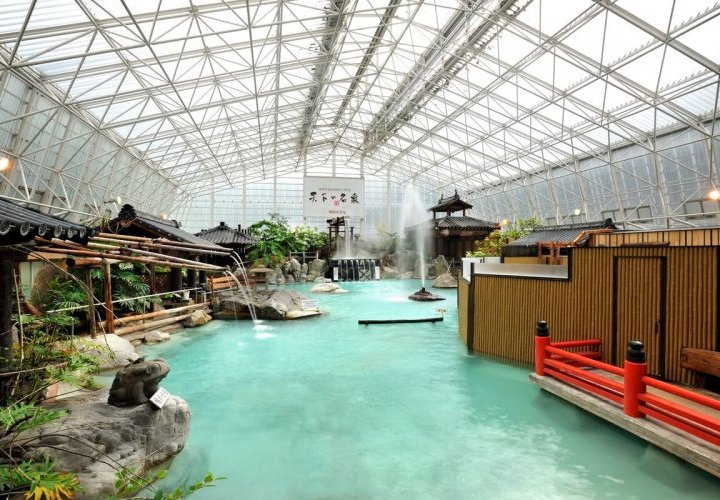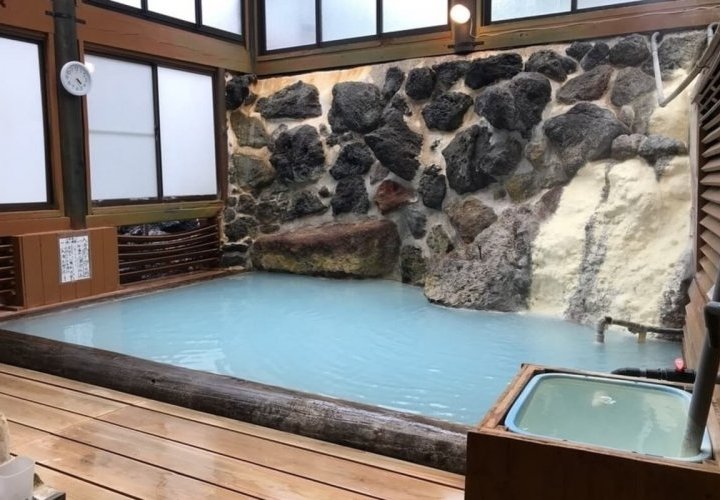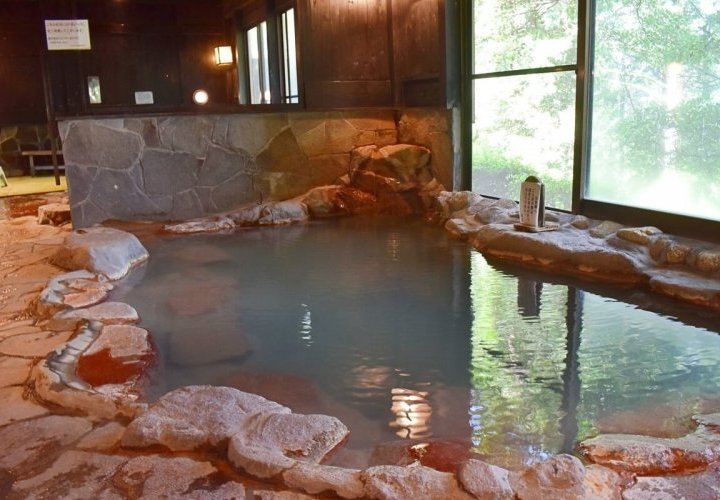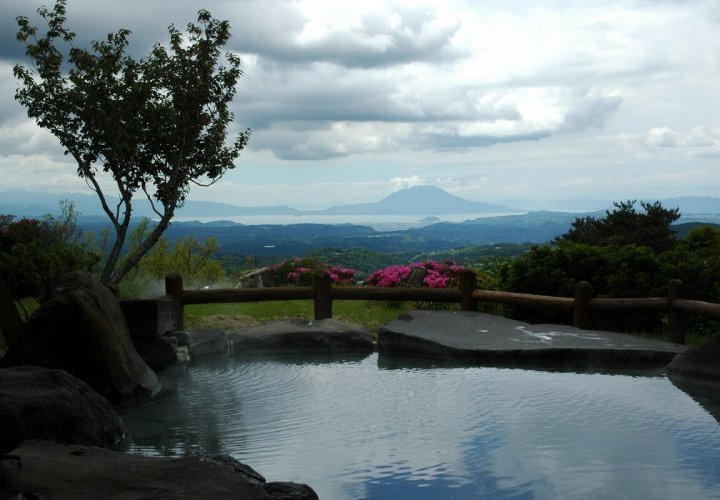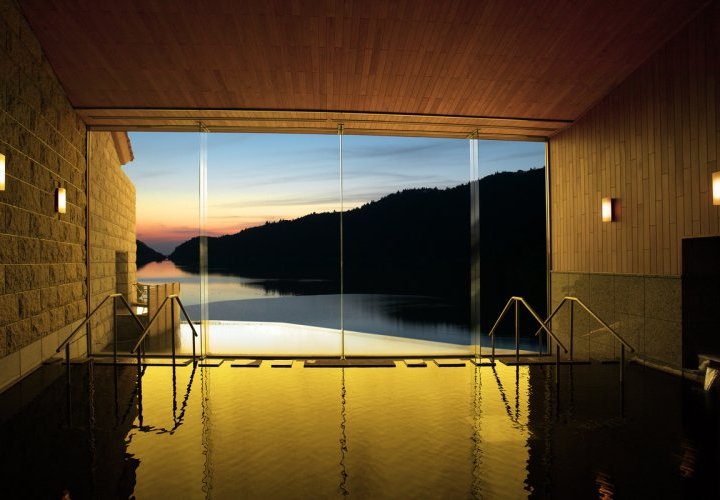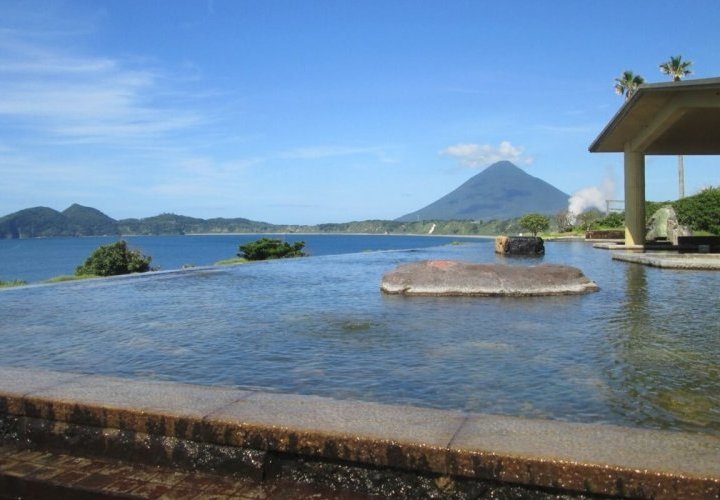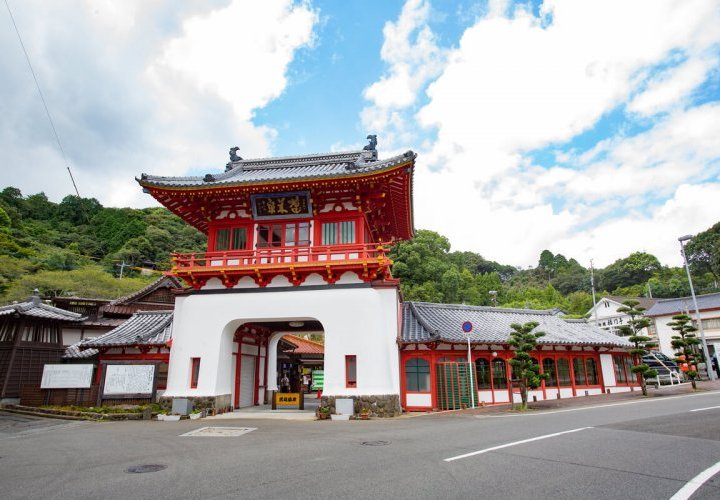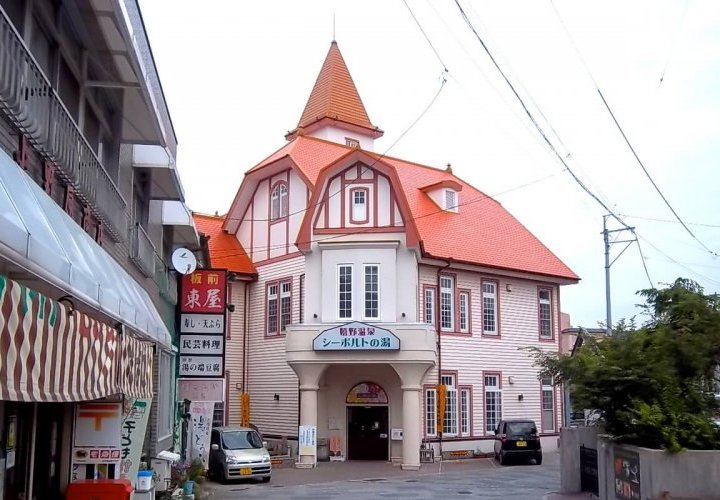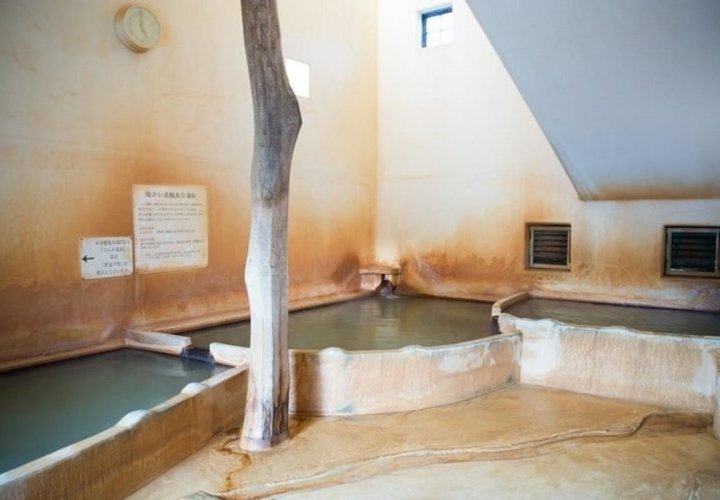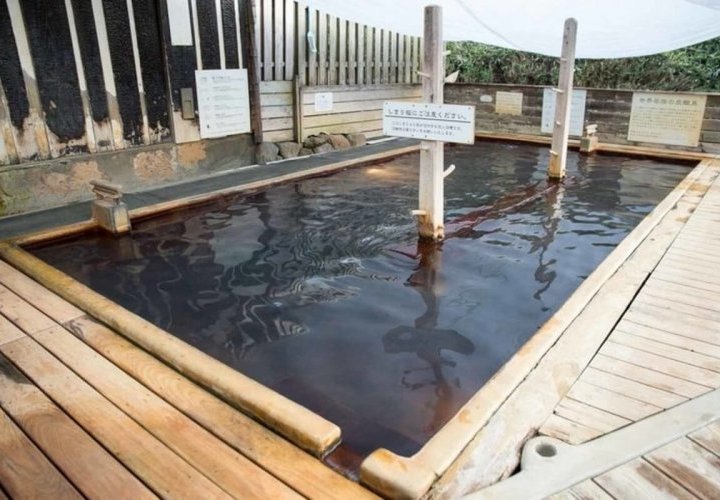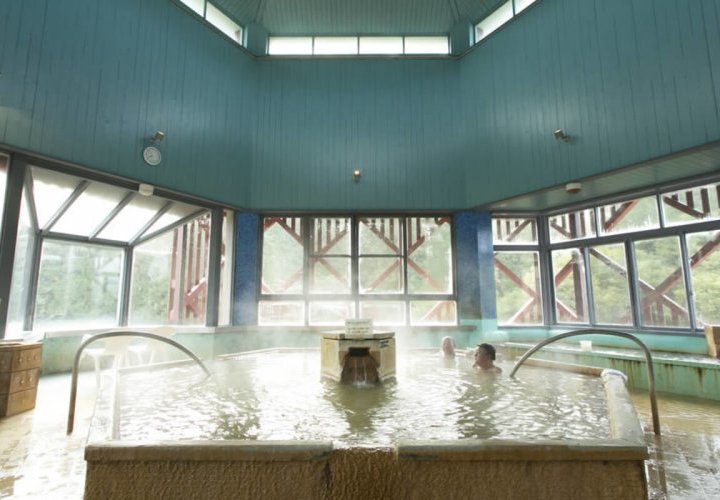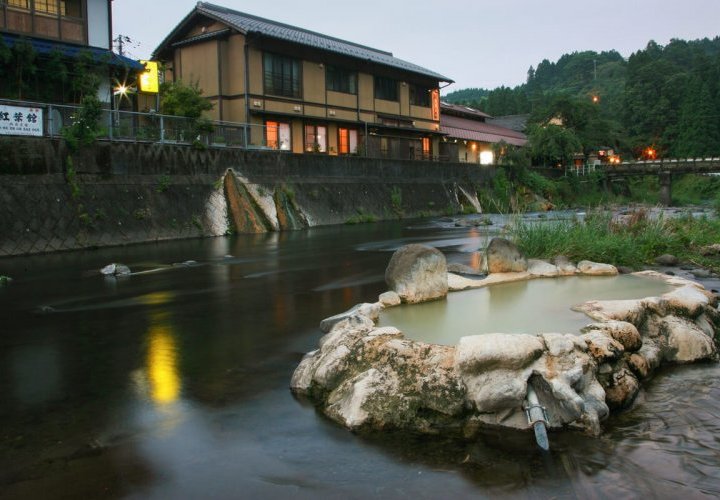Natural colours and materials, wooden buildings, earthen walls, stone stairs, a river flowing through and bridges that lead over the river directly to ryokan entrances dominate Kurokawa’s townscape. The town centre, located in a forested valley, is compact and easily explored on foot, therefore a walk in yukata and geta sandals through the town can be particularly enjoyable. more
Yamamizuki offers its visitors impressive gender separated outdoor baths with a stunning view of the riverside flanked by the mountains. The outdoor baths of Yamamizuki are some of the best riverside baths in Japan, providing you the luxury of being one with nature while enjoying the beautiful natural mountain stream and the sound of the water trickling through the mountains. There are also some nice indoor baths here. All the pools are gender separated, so that you can feel more comfortable while soaking in the hot springs.
Iyashi no Sato Kiyashiki is a hot spring establishment located on a hilltop on the outskirts of town and was founded in 1989. The ryokan offers a large variety of pools including wooden tubs, indoor baths, standing baths and a large outdoor bath surrounded by thick foliage. All the facilities are gender separated except for the large outdoor bath.
Other important places with outdoor baths in Kurokawa are: Hozantei offering an outstanding riverside bath, Kurokawaso featuring a huge outdoor bath surrounded by trees, Oku no Yu with a large mixed outdoor bath, a small outdoor bath for women located just next to the river and a mixed small cave bath, Yamabiko Ryokan offering two gender separated outdoor baths surrounded by rocks and plants and Sato no Yu Waraku with two gender separated outdoor baths and a unique rock cave bath built with huge rocks.
While the guests staying at the ryokan can naturally enjoy their own ryokan’s baths as often as they wish, the overnight visitors and the day-trippers also have the possibility to explore any other bath in town during daytime and engage in the so-called Rotenburo Meguri or “Tour of Outdoor Baths”. For this purpose, you can purchase a wooden pass (tegata) providing admission to the baths of three different ryokan of your choice.
Beppu Onsen not only is abundant in thermal waters, but also has a wide range of bath types including sand baths where bathers are buried in naturally heated sand, more
Each area had flourished as an individual resort primarily and some areas have a long history tracing back to the 9th century. Each zone has ryokans, as well as external onsen facilities and ryokan guests can visit several different spas while staying at a single ryokan. Many ryokans located near the sea have open-air baths that command a splendid ocean view.
Located along a mountain stream, Shibaseki Onsen is a picturesque and quiet onsen area noted for its hot steam bath. It has a history tracing back to 895 when it is said that the Emperor Daigo, and later in 1044 the Emperor Goreisen, visited the area to soak in the therapeutic waters. Its name Shibaseki was derived from the fossil firewood (Shiba) found there in the Edo Period. Municipal Shibaseki Hot Spring was reopened as Fureai-Yasuragi (heart-warming) Hot Spring in April 1997 with two baths of different temperature, an outdoor bath, a steam bath and a newly-built family bath and is currently designated a National Health Onsen Resort.
Another onsen that is known for steam baths is Kannawa Onsen. With many jets of white steam rising from gushing hot springs, this area is a must-see attraction for Beppu visitors. The area around the steam bath has become the heart of Kannawa and has flourished with many public baths, ryokan and souvenir shops lined along the narrow and winding streets. Kannawa Onsen was designated a National Health Hot Spring Resort.
Kamegawa Onsen area is much enjoyed for its rustic scenery. Beppu Kaihin Sunayu is known for its open-air sand bath found near Beppu city’s seashore, on the waterfront in Shoningahama Park. Beppu Beach Sand Bath, one of the most popular of Beppu, is heated by geothermal hot spring water seeping out of the earth. After you change into a yukata and lay down on the warm sand, the personnel called sunakake-san (sand “sprinklers”) will sprinkle sand to cover your body. After this procedure, your mind and body will be refreshed and fatigue and muscle pain will go away.
Beppu Onsen is the most popular area including substantial hot spring facilities. Takegawara Hot Spring, the symbol of Beppu Onsen, offers a retro atmosphere, the typical hot spring and a sand bath experience all in one place. The typical bath is located on the right side of the first floor, opposite the sand bath. There is a small changing area before you descend a set of stairs leading to the bath.
Located in Myoban district on the hill facing Beppu Bay, Myoban Onsen is a small and quiet mountain resort where you can enjoy a mud bath or a bluish milky water bath accompanied by a distinctive sulphuric odour. The complex also features shops and huts for the production of yunohana (sulphuric powder) and you will be able to see the thick smoke rising from the straw-thatched huts called Yunohana-goya. Alike Shibaseki and Kannawa, Myoban Onsen was designated a National Health Hot Spring Resort.
Other important hot spring areas are: Hamawaki Onsen (the birthplace of Beppu Onsen), Kankaiji Onsen (having the finest endowments of nature among the eight hot springs) and Horita Onsen (a rustic hot-spring resort with soothing waters appreciated since the Edo Period).
Yufuin stands on a flat river basin surrounded by mountains and the most prominent feature of the area is the twin peaked Mount Yufu, a 1,583.3 m volcano. Another natural landmark of Yufuin is Lake Kinrinko, located about 1.5 kilometres away from Yufuin Station, at the end of the main walking route of the town. The lake is surrounded by walking paths and there is a small shrine located at its southern end. There are also a few public bath houses, one of which, the Shitanyu, more
There is a large number of ryokan and hotels with hot spring baths, some of which open their baths to day- trippers. The spring waters of Yufuin Onsen are mainly clear simple hot springs. However, there are some blue-coloured springs, that are said to have a natural moisturizing effect on the skin. Such springs can be enjoyed at Tsuka no Ma (formerly known as Shoya no Yakata) ryokan located on a hillside in the northern part of Yufuin. The ryokan has large, gender separated outdoor baths with blueish-looking water and you will be able to see large steam clouds rising into the air from the hot spring sources. The baths are also accessible to non-staying visitors and are very popular among those interested in beauty care.
Another impressive ryokan in the area is Musoen. It is located on a hill in the southern part of Yufuin Basin and offers a magnificent panoramic view of Mt. Yufu and Yufuin Basin. A little out of town (about 20 minutes on foot from the station), this ryokan has large gender separated outdoor baths with exceptionally clear waters. Private “family” baths are also available at the onsen ryokan.
The twin peaks of Mount Yufu are also visible on clear days from the outdoor baths of Baien ryokan located slightly above the town to the south. It has large attractive outdoor baths and gender separated facilities.
Some of the most accessible baths to tourists without private means of transportation are offered by Sansuikan ryokan. It is located just a short walk (about 8 minutes) from Yufuin Station and offers large separated bathing facilities featuring outdoor and indoor pools, a scented bath and a sauna.
Some of Kirishima Onsen’s best baths can be found at Kirishima hotel, Shinmoeso inn, Sakura Sakura public bath house and Ryokojin Sanso ryokan.
Located in a huge covered hall, more
Shinyu Onsen - Shinmoeso offers simple but very atmospheric hot springs with pipes all over the place. There is a mixed outdoor pool and several small gender separated indoor pools with excellent sulphuric waters. Besides the baths, Shinmoeso inn provides simple Japanese-style rooms, dinner and breakfast for overnight staying guests.
Sakura Sakura is a remarkable public bathhouse with attached ryokan offering gender separated medium sized indoor and outdoor pools with sulphuric and mildly acidic water. It is said to be beneficial for the skin and to help relieve nerve pain, stiff shoulders and fatigue. A unique attraction of this place is the slightly radioactive mud, transported in from a nearby hot spring source, which soakers can apply to their skin for a few minutes for skin health and beauty before washing it off in the pool. The beneficial ingredients in the mud will leave the skin silky, radiant and soft.
The views of Kinko Bay and Sakurajima volcano in the distance from the outdoor pool are the main attraction of Ryokojin Sanso ryokan. Located on a quiet hill of a highland, the ryokan offers you the possibility to enjoy an open-air bath surrounded by wild nature and the only sounds you will hear are those of birds chirping and leaves rustling in the wind.
Unzen Onsen is a hot spring resort town located on Shimabara Peninsula not far from Nagasaki, near the peak of Mount Unzen. The resort was one of the first to open for people from all over the world and is still widely popular. On several sides, it is surrounded by hot spring fields also known as the Hells of Unzen or Unzen Jigoku in Japanese. These barren rocky areas are easily recognizable for their steam vents and gushing hot springs from which milky, acidic and sulphur water bubbles straight up out of the ground. The sulphur-based spring water is well-known for its effective sterilization power, making this onsen a great place to cure eczema, heal cuts and nourish the skin. It also has a great effect on chronic rheumatism and neuralgia, and can help relieve stress and fatigue in no time.
There are hotels and ryokan in the town that have their own baths for staying guests and several public hot spring baths around Unzen Onsen where the day-trippers can try out the hot spring waters. The traditional public baths including Shin-yu, Furuyu and Kojigoku are very much enjoyed by people in this town. Kojigoku Onsen is a small public bathhouse nestled in the forest and can be reached in about 15 minutes on foot from the town centre. It has two beautiful rustic stone baths and massaging waterfalls in each gender separated area. Behind Kojigoku hot spring, there is another small heart-shaped spring bath, famous for being a source of gushing love. The relaxing atmosphere of the baths will surely make you forget the time, while the hot spring water will leave your skin healthy, soft and beautiful.
One of the hotels in the area offering its baths for day-trippers is Azumaen. It has a large bath with a wading pool, an outdoor bath, and a cypress wind bath with sauna. While lounging in the hot waters you will enjoy an amazing view of the duck pond and the mountain scenery of Unzen.
The sand baths of Ibusuki can be enjoyed at a number of hotels and other facilities, but the most popular bathing spot is the large Saraku Sand Bath Hall, which has large facilities, indoor baths, a steam room and spots for sand baths on the beach. It is about a kilometre from Ibusuki Station and is the first spot to visit in Ibusuki for the majority of travellers. Dressed in light yukata (lightweight cotton kimono) you are invited to lie down on a secluded section of the beach. more
There are a number of other activities visitors can enjoy in the city such as discover the local history and various displays of pottery at Satsuma Denshokan Museum, view the ocean and nearby Mount Kaimondake from the lookout point of Cape Nagasakibana at the very southern end of Ibusuki or enjoy another fantastic bathing experience at the outdoor baths of Healthy Land. The most impressive baths of Healthy Land are a couple of large, gender separated rotenburo (outdoor baths) along the coast with spectacular views. The regular indoor baths and sand baths can be found at its second building about 500 metres away.
Currently, tourists and locals can enjoy the waters of Takeo Onsen at several public bath houses found around the town’s iconic Sakura-mon, a two-storied red-lacquered gate that is the symbol of Takeo Onsen and was designated Important Cultural Property of Japan. more
The main public bath, Motoyu has two simple pools (a hot one and very hot one) for each gender, while Horaiyu offers each gender only one pool. The third bath, Saginoyu has more facilities, including outdoor baths and a sauna.
Behind the Sakura-mon Gate stands Takeo Onsen Shinkan built in 1915 that used to serve as a public bath house in the past, but is now a museum displaying its tiled Roman baths and tatami-covered rest zones that are not in use anymore.
The visitors to Ureshino can try the local spring waters at the Siebold no Yu, a public bathhouse named after the 19th century German scientist who enjoyed bathing in the town during his stay in Japan. The Taisho-style gothic building, Siebold-no-Yu, has two-stories and is about 750 square metres in size. Inside you will find a common bathing area, private baths for rent, a citizen’s gallery and much more, making it a great place for relaxation among locals and tourists. Furthermore, there are over 30 hotels and ryokan, more
Ureshino is also known for its tea and boiled tofu (yudofu). There are terraces of tea fields sprawling out one after the next in Ureshino. The cultivation of Ureshino tea began between 1648 and 1651 by the tea grower, Jinbei Yoshimura. Tea seeds were gathered from Mount Sefuri and planted in the mountainous region of Ureshino Onsen, which was ideal as a tea growing area.
The hot spring resort that has the most carbonated waters in the entire Nagayu is Ramune Onsen (also written as Lamune Onsen), sometimes called the “soda pop” hot spring. You are recommended to try in rotation both the 32ºC outdoor bath and the 42ºC indoor mineral bath. The impressive resort buildings, combining modern and traditional Japanese architectural elements, more
The real symbol of Nagayu, however, is Gozen’yu hot spring facility that describes itself as centre for hot-spring therapeutic culture and draws from a water source once used by the local feudal lords. Boasting an eye-stopping western design evoking German architecture, Gozen’yu offers something for each guest, from its large main bath to a rotenburo, a cold-water spring bath, a sauna, and even a family-sized private bath that can be rented just for you and your loved ones.
Anoter of the best loved spots of Nagayu is the Gani-yu, or “crab bath”, a mixed outdoor bath on the rocky banks of the Serikawa River. The tub was built of stacked rocks and stones in the shape of a crab, thus earning the name of “crab bath”.

